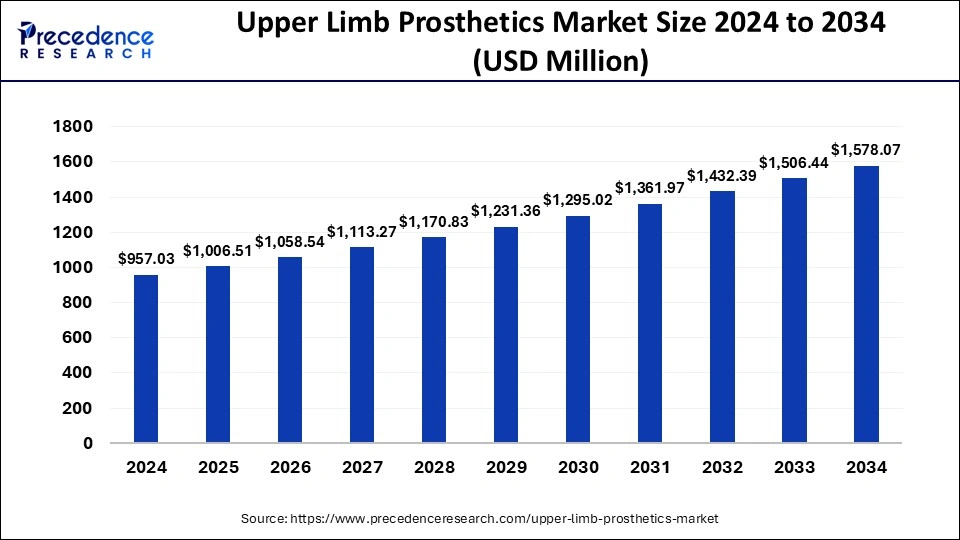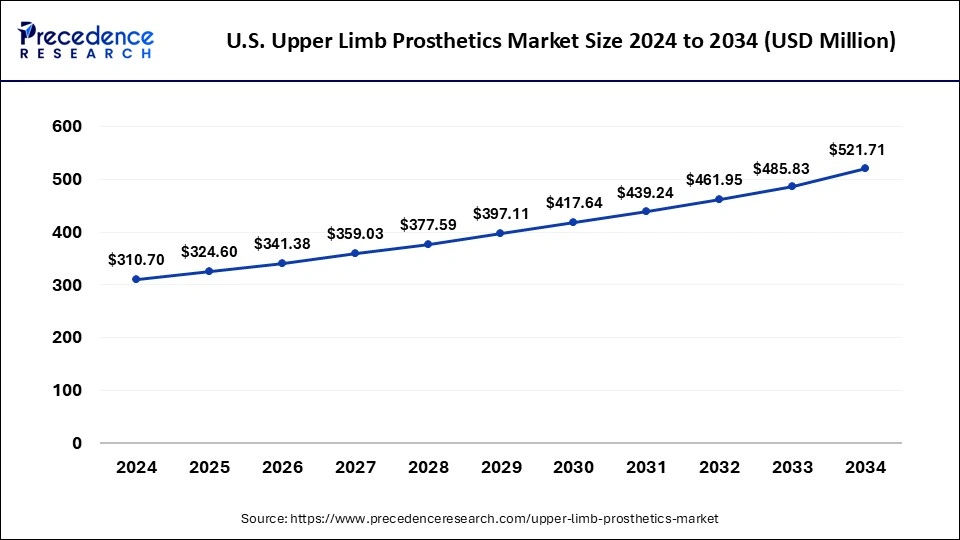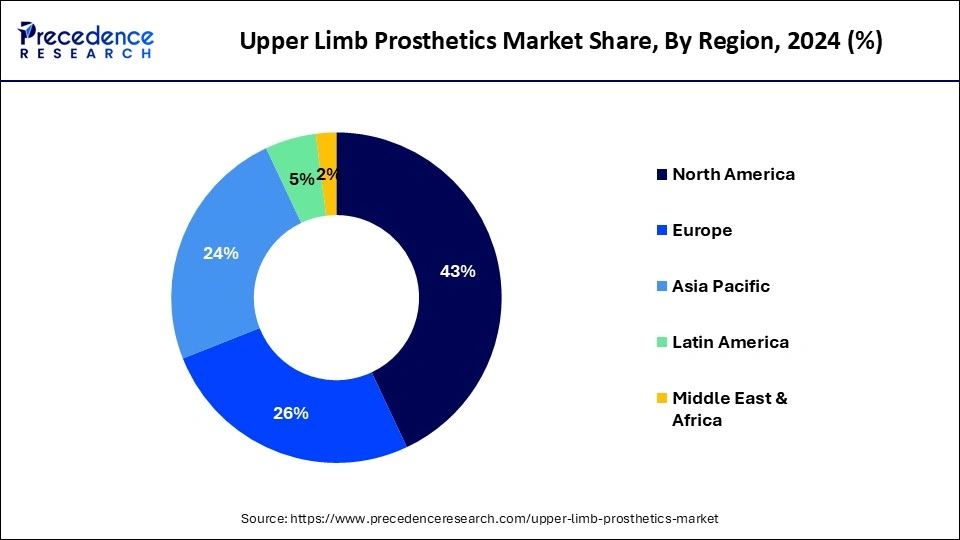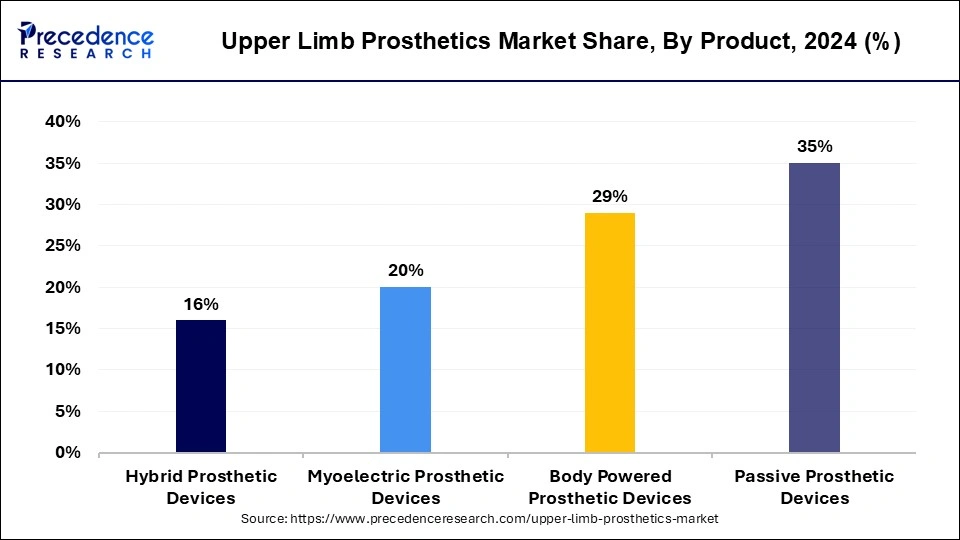January 2025
The global upper limb prosthetics market size accounted for USD 1,006.51 million in 2025 and is forecasted to hit around USD 1,578.07 million by 2034, representing a CAGR of 5.13% from 2025 to 2034. The North America market size was estimated at USD 411.52 million in 2024 and is expanding at a CAGR of 5.25% during the forecast period. The market sizing and forecasts are revenue-based (USD Million/Billion), with 2024 as the base year.
The global upper limb prosthetics market size was calculated at USD 957.03 million in 2024 and is predicted to increase from USD 1,006.51 million in 2025 to approximately USD 1,578.07 million by 2034, expanding at a CAGR of 5.13% from 2025 to 2034. The market is growing due to the increased occurrence of osteosarcoma worldwide, a rise in sports injuries, and an uptick in road accidents.

The U.S. upper limb prosthetics market size was exhibited at USD 310.70 million in 2024 and is projected to be worth around USD 521.71 million by 2034, growing at a CAGR of 5.32% from 2025 to 2034.

North America dominated the upper limb prosthetics market with a substantial share of 43% in 2024. This significant market presence is attributed to a rise in accidents and traumas, increased prosthetic surgeries, growing demand for prosthetic devices, advanced healthcare facilities with skilled professionals, and the strong presence of key industry players in the region.

Asia Pacific is projected to experience the highest growth during the forecast period. This growth is driven by increased healthcare spending and a rising aging population facing higher instances of osteoarthritis, osteoporosis, bone injuries, and obesity. The region's significant healthcare infrastructure development, particularly in countries like India, China, and Japan, and the flourishing medical tourism industry contributes to the growing demand for these medical devices.
The global upper limb prosthetics market is witnessing substantial development, propelled by innovations like hybrid nanomaterials that enhance prosthetic device performance, providing significantly better and more effective prosthetic limbs. These breakthroughs are substantially improving the quality of life for individuals with disabilities. Manufacturing techniques, materials, and electronics evolve, resulting in sophisticated and functional upper limb prosthetic devices. Key factors include myoelectric developments utilizing muscle signals for hand movement control and the application of 3D printing for personalized prostheses.
Advancements in the field are driving significant growth in the upper limb prosthetics market. The yearly toll of nearly 1.3 million lives due to global traffic accidents, as reported by the World Health Organization (WHO), emphasizes the urgent need for progress. Furthermore, there is an increased occurrence of osteosarcoma worldwide, a rise in sports injuries, and an uptick in road accidents.
| Report Coverage | Details |
| Growth Rate from 2025 to 2034 | CAGR of 5.13% |
| Market Size in 2025 | USD 1,006.51 Million |
| Market Size by 2034 | USD 1,578.07 Million |
| Base Year | 2024 |
| Forecast Period | 2025 to 2034 |
| Segments Covered | Component, Product Type, and End-user |
| Regions Covered | North America, Europe, Asia-Pacific, Latin America, and Middle East & Africa |
Increasing geriatric population across the globe
The elderly population is more susceptible to falls and accidents due to age-related weakness. The increasing emphasis on independence among the global elderly population is expected to drive the growth of the upper limb prosthetics market. There are over 610 million individuals, accounting for approximately 8% of the world's population, aged 65 or older. In cases where limb-sparing or limb-salvage surgery is performed, such as for arm bone tumors, upper limb amputations may occur. Prosthetic equipment, like upper limb prosthetics, becomes essential to aid function after amputation.
Leveraging machine learning
Researchers at the Florida Atlantic University College of Engineering and Computer Science are incorporating stretchable tactile sensors using liquid metal on the fingertips to develop prosthetic hands with a more natural feel. The latest technology offers significant advantages over traditional sensors, featuring high stretchability, flexibility, and conductivity. While an average human fingertip has about 3000 touch receptors, those with upper limb amputations lack this pressured sense of touch. In a recent study, researchers used individual fingertips on the prosthesis to distinguish between different speeds of sliding motions on various textured surfaces, employing only one variable parameter: the distance between ridges. This can boost the growth of the upper limb prosthetics market.
Stringent regulatory requirements and high costs
The upper limb prosthetics market faces challenges due to the high costs associated with these prostheses, acting as a barrier for amputees. Additionally, stringent regulatory requirements, mainly overseen by the U.S. Food and Drug Administration (FDA), hinder market growth. The FDA closely monitors the development, approval, and post-approval effects of medical devices, including upper limb prosthetics, categorizing them as class II devices. These devices must undergo a complex 510(k) approval process to gain commercial approval, demonstrating both safety and efficacy.
Myoelectrics development
In the upper limb prosthetics market, the discovery of myoelectric has opened lucrative business opportunities for key players. Electric prostheses, or myoelectric prostheses, operate through electric signals generated by the body's muscles. These prosthetics utilize existing muscles in the residual limb, allowing users to control the device's functions. A sensor within the prosthesis captures electrical signals from the muscles, translating them into movements. This technology provides a natural-looking prosthesis that leverages existing nerves for functional use. The demand for such prosthetics is expected to rise globally, mainly due to traumatic cases resulting from accidents or injuries that lead to losing body parts, such as fingers, toes, arms, or legs.
Versatile treatment and technological advancement
Upper-limb prosthetics now offer treatment for trauma, vascular complications, and bone cancer at various levels, such as trans phalangeal, transmetacarpal, transcarpal, wrist, transradial, transhumeral, interscapulothoracic. Technological advancements have driven the demand for upper-limb prosthetics, contributing to the growth of the myoelectric prosthetics market, prosthetic arm market, and upper-limb prosthetics market. Emerging innovations, including suspension systems and osseointegration, are gaining popularity. 3D printing is also becoming prevalent in upper limb prosthetics due to its cost-effectiveness and faster construction time.
The prosthetic arm segment dominated the upper limb prosthetics market in 2024 and is expected to experience further growth over the forecast period. This is attributed to the increase in road accidents, a growing elderly population, and a rise in the prevalence of joint disorders like osteoarthritis in both developed and developing countries. Moreover, ongoing innovations in materials, sensors, and design have led to prosthetic arms that closely emulate natural hand movements, providing enhanced agility and control.
The prosthetic wrist segment is poised for significant growth in the forecast period. Continuous technological advancements play a vital role in propelling the development of the prosthetic wrist segment. The segment's expansion is further fueled by the increased functionality offered by modern prosthetic wrists, enabling users to perform a broader range of daily activities with greater precision. Studies, such as one published in the Journal of Prosthetics & Orthotics, underscore significant strides in prosthetic wrist functionality, contributing to users' independence and overall improvement in quality of life.
The passive prosthetic device segment dominated the largest market share of 35% in 2024. The segment is driven by critical factors such as an increase in amputees, a higher demand for upper limb prosthetic surgeries, rising patient awareness about prosthetic devices, and advancements in prosthetic technology. These factors have contributed to the notable expansion of the passive prosthetics segment.

The body-powered prosthetic devices segment is expected to experience the fastest growth rate during the forecast period. These devices feature simpler designs with fewer components, making them a cost-effective choice for patients. Their minimal electronic components contribute to lower maintenance requirements and reduced risk of malfunctions, ultimately enhancing patient satisfaction.
The prosthetic clinics segment dominated the market share in 2024. The rising incidence of limb amputation, attributed to factors like sports injuries, diabetes, vascular diseases, and other accidents, is boosting the demand for specialized clinic services in the field. Clinics offering customized as well as personalized prosthetic solutions via skilled experts providing expert evaluation, fitting, and continuous care for prosthetic limbs are attracting more patients and contributing to the segment's rapid growth.
Besides the dominant clinics segment in the upper limb prosthetics market, the hospital's segment has shown a significant presence. This segment is poised for substantial growth throughout the forecast period. Hospitals are at the forefront of adopting and providing cutting-edge prosthetic technologies and devices, making them appealing to patients seeking advanced and innovative solutions. This trend is expected to drive significant growth in the hospital segment.
By Component
By Product Type
By End-user
By Geography
For inquiries regarding discounts, bulk purchases, or customization requests, please contact us at sales@precedenceresearch.com
No cookie-cutter, only authentic analysis – take the 1st step to become a Precedence Research client
January 2025
January 2025
November 2024
August 2024